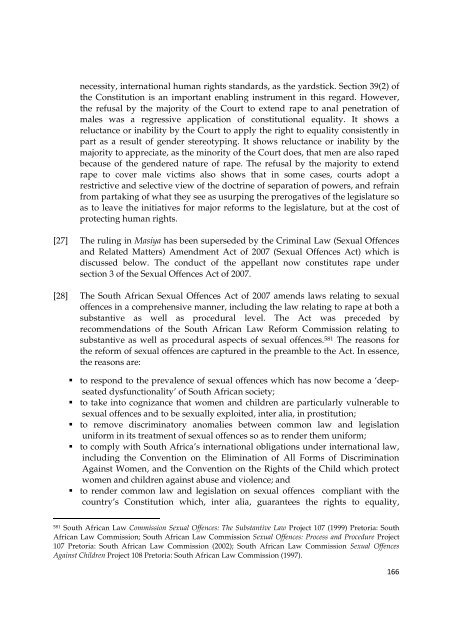sexual health and human rights in the african region - The ICHRP
sexual health and human rights in the african region - The ICHRP
sexual health and human rights in the african region - The ICHRP
Create successful ePaper yourself
Turn your PDF publications into a flip-book with our unique Google optimized e-Paper software.
necessity, <strong>in</strong>ternational <strong>human</strong> <strong>rights</strong> st<strong>and</strong>ards, as <strong>the</strong> yardstick. Section 39(2) of<br />
<strong>the</strong> Constitution is an important enabl<strong>in</strong>g <strong>in</strong>strument <strong>in</strong> this regard. However,<br />
<strong>the</strong> refusal by <strong>the</strong> majority of <strong>the</strong> Court to extend rape to anal penetration of<br />
males was a regressive application of constitutional equality. It shows a<br />
reluctance or <strong>in</strong>ability by <strong>the</strong> Court to apply <strong>the</strong> right to equality consistently <strong>in</strong><br />
part as a result of gender stereotyp<strong>in</strong>g. It shows reluctance or <strong>in</strong>ability by <strong>the</strong><br />
majority to appreciate, as <strong>the</strong> m<strong>in</strong>ority of <strong>the</strong> Court does, that men are also raped<br />
because of <strong>the</strong> gendered nature of rape. <strong>The</strong> refusal by <strong>the</strong> majority to extend<br />
rape to cover male victims also shows that <strong>in</strong> some cases, courts adopt a<br />
restrictive <strong>and</strong> selective view of <strong>the</strong> doctr<strong>in</strong>e of separation of powers, <strong>and</strong> refra<strong>in</strong><br />
from partak<strong>in</strong>g of what <strong>the</strong>y see as usurp<strong>in</strong>g <strong>the</strong> prerogatives of <strong>the</strong> legislature so<br />
as to leave <strong>the</strong> <strong>in</strong>itiatives for major reforms to <strong>the</strong> legislature, but at <strong>the</strong> cost of<br />
protect<strong>in</strong>g <strong>human</strong> <strong>rights</strong>.<br />
[27] <strong>The</strong> rul<strong>in</strong>g <strong>in</strong> Masiya has been superseded by <strong>the</strong> Crim<strong>in</strong>al Law (Sexual Offences<br />
<strong>and</strong> Related Matters) Amendment Act of 2007 (Sexual Offences Act) which is<br />
discussed below. <strong>The</strong> conduct of <strong>the</strong> appellant now constitutes rape under<br />
section 3 of <strong>the</strong> Sexual Offences Act of 2007.<br />
[28] <strong>The</strong> South African Sexual Offences Act of 2007 amends laws relat<strong>in</strong>g to <strong>sexual</strong><br />
offences <strong>in</strong> a comprehensive manner, <strong>in</strong>clud<strong>in</strong>g <strong>the</strong> law relat<strong>in</strong>g to rape at both a<br />
substantive as well as procedural level. <strong>The</strong> Act was preceded by<br />
recommendations of <strong>the</strong> South African Law Reform Commission relat<strong>in</strong>g to<br />
substantive as well as procedural aspects of <strong>sexual</strong> offences. 581 <strong>The</strong> reasons for<br />
<strong>the</strong> reform of <strong>sexual</strong> offences are captured <strong>in</strong> <strong>the</strong> preamble to <strong>the</strong> Act. In essence,<br />
<strong>the</strong> reasons are:<br />
to respond to <strong>the</strong> prevalence of <strong>sexual</strong> offences which has now become a ‘deepseated<br />
dysfunctionality’ of South African society;<br />
to take <strong>in</strong>to cognizance that women <strong>and</strong> children are particularly vulnerable to<br />
<strong>sexual</strong> offences <strong>and</strong> to be <strong>sexual</strong>ly exploited, <strong>in</strong>ter alia, <strong>in</strong> prostitution;<br />
to remove discrim<strong>in</strong>atory anomalies between common law <strong>and</strong> legislation<br />
uniform <strong>in</strong> its treatment of <strong>sexual</strong> offences so as to render <strong>the</strong>m uniform;<br />
to comply with South Africa’s <strong>in</strong>ternational obligations under <strong>in</strong>ternational law,<br />
<strong>in</strong>clud<strong>in</strong>g <strong>the</strong> Convention on <strong>the</strong> Elim<strong>in</strong>ation of All Forms of Discrim<strong>in</strong>ation<br />
Aga<strong>in</strong>st Women, <strong>and</strong> <strong>the</strong> Convention on <strong>the</strong> Rights of <strong>the</strong> Child which protect<br />
women <strong>and</strong> children aga<strong>in</strong>st abuse <strong>and</strong> violence; <strong>and</strong><br />
to render common law <strong>and</strong> legislation on <strong>sexual</strong> offences compliant with <strong>the</strong><br />
country’s Constitution which, <strong>in</strong>ter alia, guarantees <strong>the</strong> <strong>rights</strong> to equality,<br />
581 South African Law Commission Sexual Offences: <strong>The</strong> Substantive Law Project 107 (1999) Pretoria: South<br />
African Law Commission; South African Law Commission Sexual Offences: Process <strong>and</strong> Procedure Project<br />
107 Pretoria: South African Law Commission (2002); South African Law Commission Sexual Offences<br />
Aga<strong>in</strong>st Children Project 108 Pretoria: South African Law Commission (1997).<br />
166
















